Convectors embedded in the floor: varieties of devices, design features, lattice design, specifications, installation principles.
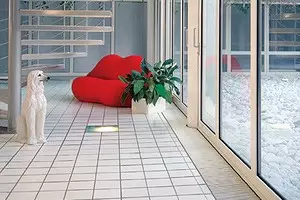
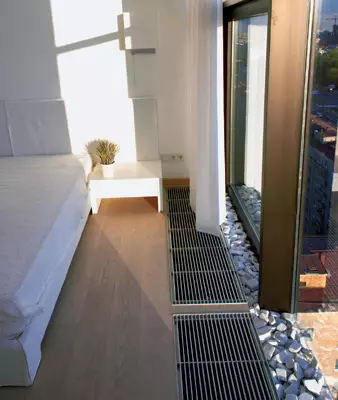
Photo E.Frampol
Curtains over convectors hang undesirable. However, if it does not do without it, it is necessary that they do not interfere with the air circulation through the convector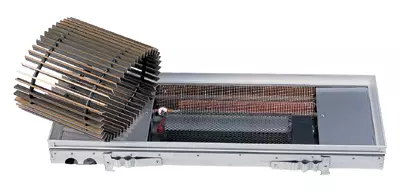
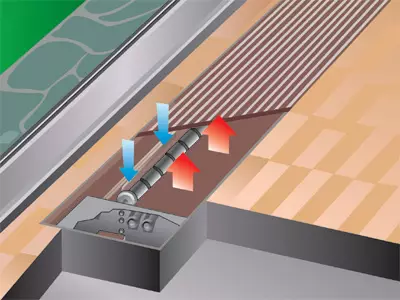
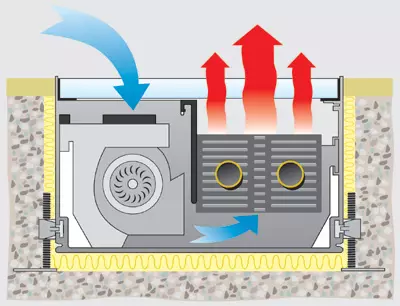
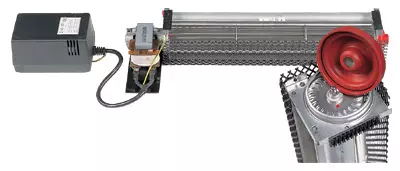
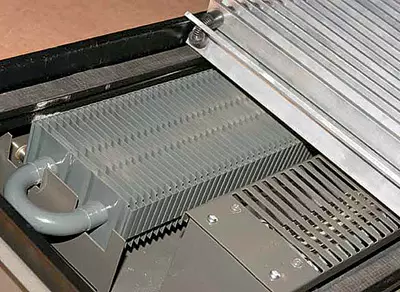
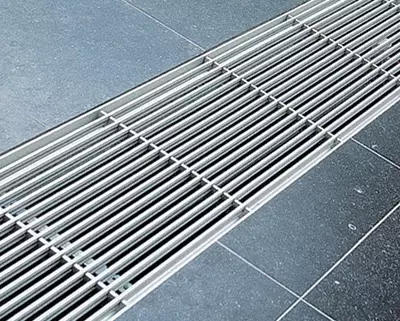
To protect against damage, fans of embedded convectors are closed with coves
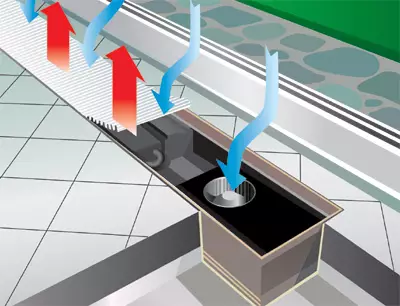
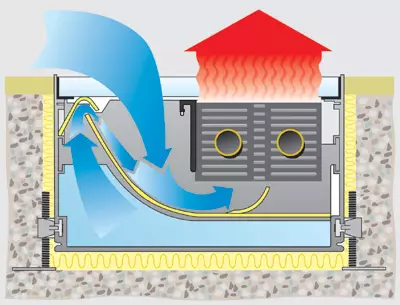
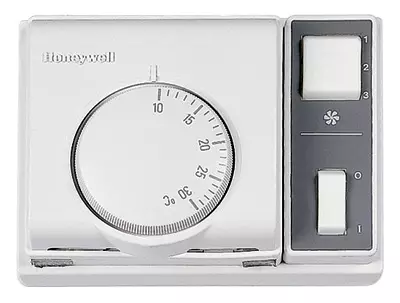
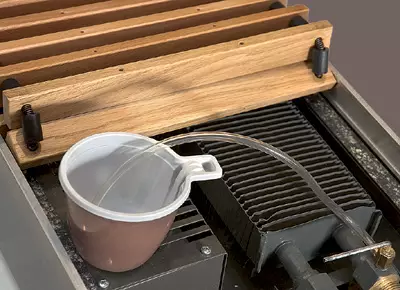
The windows from the floor to the ceiling - the dream of many developers. Only here how to heat the room decorated with these transparent designs? Traditional batteries under high windows will not deliver, will be blown away daylight, spoil the view of the surroundings, will take place in the dispensary with the interior and distort the perception of the appearance of the building. But there is still a yield: to equip effective heating without prejudice (and possible, and with benefit) for design allow you to be built into the floor convectors.
Dream designer
Most often, convectors embedded in the floor are used in cottage heating systems, less often when heating urban apartments. For the first time getting into the field of vision of the buyer in the store or in the construction market, such a device is usually perceived as a long low box having a lid in the form of a decorative grid. Under the grille, in the housing (it is also called a chute), the heat exchanger is installed (the tube with plates rolled to it), which connects to the heating system, the air temperature in the room increases from the contact with it. In addition to the heat exchanger, small fans with electric motors (one or more) can be located in the gutter of the convector, allowing to accelerate the heating of the room due to the intensive blowing of the heat exchanger, as well as various regulatory devices. The convector with the fan is also referred to as being built to the floor of the Fankeal - we have already written about such equipment in one of our magazine's past numbers.During the installation of the housing of the embedded convectors is hidden in the floor design. They are immersed in the cement screed ("give a precipitate") or are installed in the openings organized in raised floors. After completing the laying of the floor covering, only decorative lattices, located flush with a pure surface will remain visible. The uninimbered man, going into a room heated by embedded convectors, is unlikely to immediately determine where heat goes from, - did these narrow "carpets", laid down under the windows? ..
Designers are found in the convectors built into the floor such a desired embodiment of the "invisible batteries". ABSE Because embedded convectors can organically fit in almost any interior.
The color of the grille embedded in the floor of the convectors can be "fit" under the color of the floor covering or other important elements of the internal decoration of the house: upholstery of furniture, curtains, color of wallpaper IT.D. Fortunately, most manufacturers of convectors offer a rather rich palette of possible shades of lattice coloring. Grilles are made, as a rule, from aluminum (without decoration, anodized or plated polymer paint), valuable wood species (oak, beech, mahogany, nut, less often birch) or plastic. The crossbars, of which the lattice consists, can be located across the gutter convector, such a product is similar to the rope staircase and is flexible (it is easy to roll in the bay, which is convenient, let's say, when cleaning the room). Along the gutter there are crossbars of rigid and semi-rigid aluminum lattices (in the last linear elements are bonded with each other with special flexible springs, allowing you to clearly observe the dimensions and not weighing the design).
Serial convectors have a rectangular shape, their sizes once and are forever defined by the manufacturer. Thus, the width of the lattice is 140-430mm, the length is 800-5000mm. But if a rectangular shape and standard devices do not suit you for some reason, you can order the appropriate option "for a specific room". Theoretically embedded convectors may have an unlimited length and curvilinear form. The connection of the lattices on the COP in the corners of the room is proposed (the angle of their articulation in some manufacturers is only 90, and others are ranging from 0 to 180). The convector may repeat the contours of the curvilinear sections of the walls (for example, in erkers), to ride columns IT.D. Under the order are made lattices with metal inserts, lamps, electrical sockets and with other embedded equipment.
The heat impacts of the thermophysics are built into the floor convectors are good with their low-airing. Due to the minimal volume of hot water contained in their heat exchangers, they almost instantly respond to changing the needs of the room in warm, providing high comfort and saving money for heating.
Pensionered lattice convectors are heated no more than 40-45s, even if the temperature of the coolant is high enough. Consequently, with long-term contact with their surface, it is impossible to get a burn. However, we are still not recommended to walk bare feet on the lattices. Interior items, including leather sofas, chairs, antique wooden furniture and modern electrical equipment, can often be located in the immediate vicinity of the convector without the risk of damage. Air passing through the device is in contact with only small areas of a strongly heated heat exchanger tube, the total area of which is 3.5-5% of the entire heating area; Plates are noticeably colder. In addition, even at the maximum temperature of the coolant, the heat exchanger surface has a temperature of about 60s, which practically eliminates the burning of dust and significantly reduces (compared with other types of heaters) positive air ionization, adversely affecting the health and well-being of a person.
Not a united lattice
Of course, if the convectors included only a decorative lattice, they would be applied everywhere, and the entire procedure for choosing the device would be able to purely designer tasks. However, in practice everything is much more complicated. The selection of the lattice is carried out in the latter order, after clarifying all the thermophysical and building characteristics of the instruments. It may, let's say, it turns out that convectors designed for the depth of dive, which is available in this particular room, simply does not exist in nature. Or the thermal capacity of the equipment will be insufficient to combat the condensate falling on the windows and walls (this applies, above all, to very high rooms, for example, hills of cottages). The use of the use of embedded in the floor of the convectors in the heating systems or cooling rooms can be judged only by the results of detailed calculations, which is able to carry out only convector supplier professionals, as well as design and installation organizations that have experienced communication with such technique.
To facilitate communication with the supplier, we will look at the basic elements of the design of the embedded convectors. At the same time we divide the instruments into two groups: with a fan, intensifying heat exchange, and without a fan.
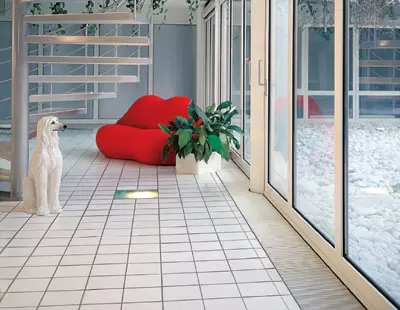
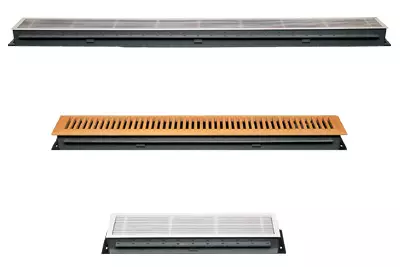
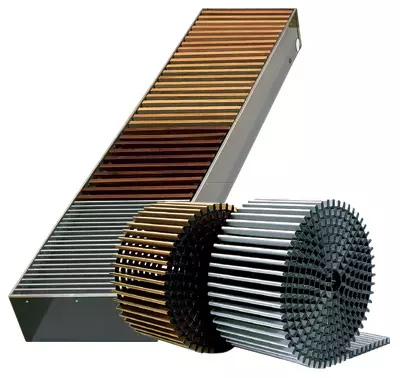
Types of decorative lattice in the convectors "Isotherm"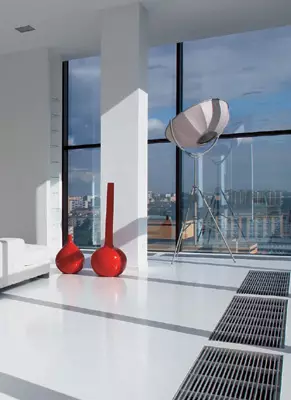
Photo E.Frampol
Rolled grille is flexible, it can be rolled into a roller when cleaning
In the middle lane of Russia, convectors without fans are usually used as an additional heating of residential premises in conjunction with floor heating system. In a ligament in a ligament, they are noticeable (several times) accelerate the reaction of the equipment to a rapid decline or temperature increase in the house. Moreover, in the spring and autumn, the warm floor can be turned off - quite enough power convectors. Theoretically, they are also suitable for the main heating systems of the cottage or apartment, but examples of the implementation of this idea are unknown to us. Empty power supply - from 127 to 720W to 1m length. Their durability, efficiency and ease of operation are largely determined by the design of the base elements and heat exchanger.
Gutter convector Usually it has reliable anti-corrosion protection. Traditionally, it makes it from "galvanizing" with a polymer coating, like KAMPMANN devices (Germany), Kaufmann (Austria), Jaga (Belgium) and a number of others. In the early time, the fashion appeared on a gutter from the "stainless steel" - in their manufacture especially succeeded by Oplflex (Czech Republic). If the convector is installed in the counterpart design, the quality of the anti-corrosion protection of the material from which the chute is made, does not have a fundamental value. It is much more important than the quality of the gutter anticorus when installing the convector in the cement-sand tie, especially when it is direct contact with the case (alkaline concrete environment destroys the metal). The most stringent requirements for the quality of the anti-corrosion protectedness of the gutter (multilayer polymer coating or "stainless steel") makes sense to present in cases where the instruments are intended for the pool or winter garden, where by quite objective reasons can be overtaken by water "by the lattice." The housings used here convectors must necessarily supply drainage.
The decorative grille is placed on the aluminum frame or steel fixed on the edge of the gutter. If the lattice is assumed to go, the support surface of the frame must be placed by a damping rubber plate (it is supplied in the basic configuration or is purchased separately). Energy saving sketches and reduce the spread of sounds in the room, located below, before mounting the convector, the outer side of the gutter can be enclosed with foamed polyethylene.
Heat Exchanger . Most often, the convectors embedded in the floor are supplied with a copper-aluminum heat exchanger, that is, a copper tube penetrating into one or more kits, a package of rectangular aluminum plates. For durability of the device, it is important how these thin plates are attached to the pipe. If they have a stamped flap, an increase in contact area several times (when looking at such heat exchangers, it may seem on the side that the plates are "flowing" on the tube), then the heat exchanger gets serious chances to maintain the efficiency of heat transfer to the room throughout the operation time. The efficacy of heat transfer increases if the heat exchanger is applied to the plates of the heat exchanger (then they become similar to slate strips). Very successful both in design and on the operational characteristics of the Copper-aluminum heat exchanger LOW-H2O completes its MINI SANAL devices. One of the recognized leaders in the production of embedded convectors is Jaga.
In addition to copper aluminum, copper heat exchangers are used in the production of embedded convectors. They are more expensive, but are distinguished by increased corrosion resistance. Thus, in the devices of the German company Mhlenhoff (the manufacturer prefers to call them by the system convectors) the heating element is an alloyed copper tube, bent into several rows, with copper plates soldered on it. Other type of copper heat exchangers is used in OPLFLEX convectors. Here the heating element has a futuristic design and is a continuously retinable spiral from copper wire with radially converging rays. It has quite high strength and hygiene.
To make the inner parts of the convectant are invisible through the grille, the heat exchanger, as well as the body, shut-off and adjusting reinforcement are covered with dark paint. It provides the anti-corrosion protection of the heating element. This technique is used by almost all manufacturers of such equipment, only color varies slightly. For example, in the convectors of the brand "Breeze-M" from KZTO (with natural convection), all the insides are made black, so it is impossible to distinguish separate parts through the grille. Supports from Jaga uses antistatic anthracite-gray coating. The internal surfaces of the convectors and the OPLFLEX heat exchanger are covered by paint by special order. The same configuration, these heating devices are supplied without painting internal surfaces than, according to the manufacturer, emphasizes the spectacular appearance of the heat exchanger.
For the convenience of installing heat exchangers of embedded convectors make both end (water to them can be brought on one side) and passing (water is supplied and removed from different sides). Better, however, if the heat exchangers make end. Since any convector built into the floor automatically turns into a collector for the most diverse garbage (especially if the apartment is not regular cleaning), for convenience of cleaning the gutter, the transmitting heat unit should be easily removed from the housing without disconnecting from the heating system and any other complex operations requiring Attracting highly qualified specialists. For reference: It is necessary to carefully clean the groove with a vacuum cleaner monthly, wet cleaning should be performed regularly (at least once a year, before the start of the heating season). The mobility of the end heat exchanger embedded to the floor of the convector is achieved due to the flexible supply, which are included in the package (like Czech MINIB convectors) or are additionally purchased.
Regulation of heating room . The heat transfer of the convector without a fan can be adjusted by changing the amount of coolant flowing through it ("adjustment from water side"). To do this, the thermostatic head with a remote control panel is intended.
| Firm | Country | Model | Type of heat exchanger | Thermal power, W * | Height, mm. | Width, mm. | Length, mm. | Cost ** |
|---|---|---|---|---|---|---|---|---|
| KAMPMANN. | Germany | Katherm NK, NKV | Copper aluminum | 108-4707 | 92,120, 150. | 182, 272, 400 | 850-4750 | 245-1666. |
| Oplflex. | Czech Republic | FLK and FLK Canal | Copper wire | 95-5668. | 90, 115, 140, 180, 300 | 170, 300, 320, 360, 420 | 800-4800 | 350-3371 |
| MHLENHOFF. | Germany | SK | Copper plate | 186-2769. (t water = 80c) | 90, 110. | 180, 320, 410 | 1000-5000 | 195-1608. |
| Minib | Czech Republic | COIL-R / RT, Ro | Copper aluminum | 299-1507 (t water = 80c) | 120, 125, 130 | 243, 303. | 900-3000 | 341-1020 |
| Jaga. | Belgium | Mini Canal | Copper aluminum | 141-3820. | 90, 110, 140, 190 | 140, 180, 260, 340, 420 | 1100-4500 | 233-1587 |
| Imp Klima. | Slovenia | TK | Copper aluminum | 236-2097 (T water = 100C) | There is no data | 200, 300, 400 | 950-2750 | 250-828. |
| KTO | Russia | "Breeze" | Copper aluminum | 248-4600. | 83, 123. | 200, 260, 380 | 800-5000 | 118-1003 |
| "Isotherm" | Russia | "Warm track" | Copper aluminum | 310-1690. | 90, 190. | 270, 430. | 900-2700 | 197-788 |
| * - temperature difference 75 / 65c, room temperature 20c; ** - Price to the device in a minimum configuration (with a reassigning aluminum lattice of natural color) |
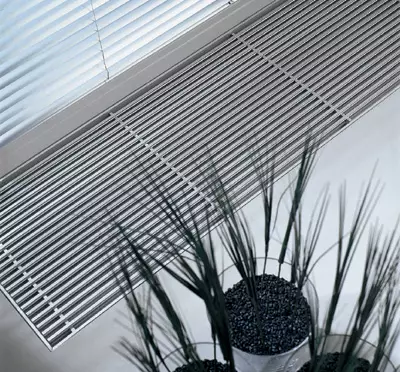
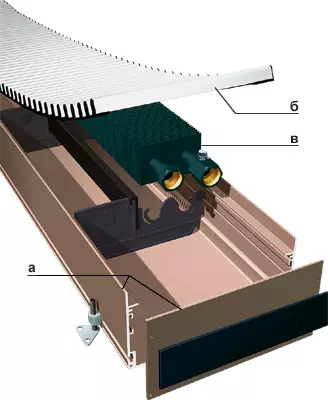
In Mhlenhoff convectors:
a chute collected from aluminum plates;
B-decorative lattice of durable plastic;
C- heat exchanger from clean copper
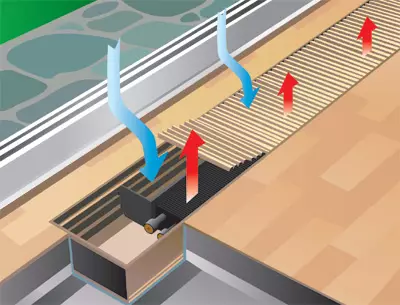
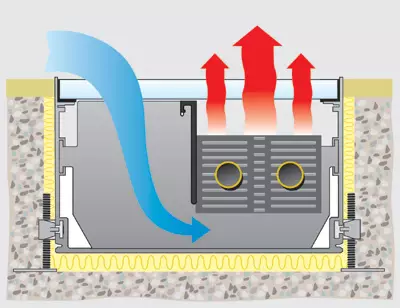
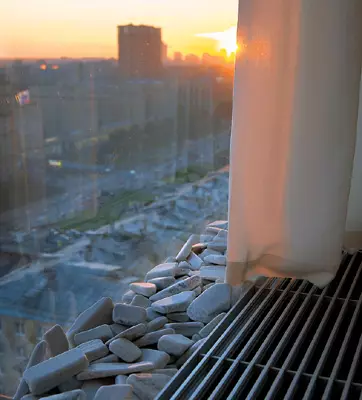
Photo E.Frampol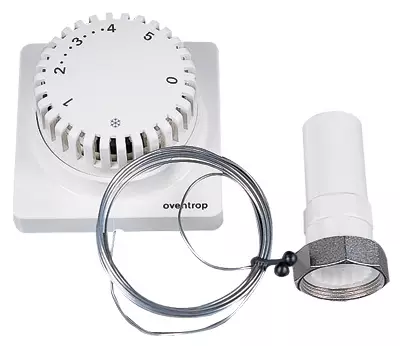
The thermal power of the embedded convectors with fans, shown to one meter of length, is within about 100Ws when the fan is turned off (the device heats the room at the expense of natural convection) to 1200W and more if the fans operate at maximum speed. (The fan itself consumes only a few dozen watts of electricity per hour.) Convectors of this group are used for both the main and for the auxiliary heating of rooms of various purposes, in particular, in cases where the heat production capacity with natural convection is not enough. Sometimes this equipment is used to form a cold air curtain near the surface of the windows under which it is installed. The curtain prevents the gear of the air of the room from the surfaces of the glasses and frames heated by the sun. This is the so-called "light" air conditioning, sensible exclusively in the location zone of convectors. In practice, it is used only in cottages equipped with a central air conditioning system, if there is a source of cold water (chiller, artesian well or other) with a temperature of 6-8C, as well as the possibility of organizing condensate removal.
When choosing to be built into the floor of a fan convectors, it logically give additional attention to the quality of the performance of fans and the capabilities of heat control systems.
Fans . Most often in the built-in convectors, the so-called tangential fans can be detected (in an amount of 1-4, depending on the length of the device). Structurally, these are electromotors, to which long "rags" - impeller are coming from one or both sides. The device is installed in parallel to the heat exchanger. Tangential fans create a flat uniform air flow of a large width, so that a uniform blowing of the heat exchanger is ensured. The design of the instruments allows you to have them in a protective cover, which covers from foreign objects from entering out, and install a filter to clean the air from large-dispersed dust (like Jaga convectors). Some manufacturers make tangential fans light grapple, which facilitates the general cleaning of the convector gutter (for example, the Oplflex fan is attached to the chute on velcro). The impeller is usually well balancing and mounted on rubber vibro-imagners.
Axial (axial) fans outwardly do not differ from those used in personal computers. These devices have a good moisture protection, are installed in pairs (opposite each other) near the heat exchanger and carry out its local blowing and intensification of the heat exchange process. The lack of axial fans is that they are not able to provide a uniform blowing the heating element.
Radial fans (one, maximum two) are installed in the end of the convector. Their advantage is the ability to create a powerful air flow, which allows to organize intensive heating of the room. Externally, the radial fan is similar to the sink snail. This help the air is inserted into the bottom part of the gutter and, through the elements of the body design, is supplied under the heat exchanger. The widespread use of radial fans may be restrained by a sufficiently high level of aerodynamic noise generated by them (blades strongly "beat" about air). True, with a competent study of the structure, this drawback is minimized. For example, in the mhlenhoff convectors, the fan node is noise insulated. The essential improvement in aerodynamic characteristics also contributes to all elements of the body design. Say, the heat exchanger is stacked on a plastic stand, designed as a flat nozzle for the intake of cold air and profiled to ensure maximum convection.
Note that the noise level generated by the fans of convectors for some buyers is of paramount importance, especially when choosing instruments for residential rooms. After all, sound stimuli have a negative, often inhibit influence on the human nervous system. It should be borne in mind that the relationship between the frequency of rotation of the fan, the heating power and noise is not a linear-noise of the equipment growing much sharp than the heating capacity. Therefore, manufacturers usually recommend picking convectors for power developing with them with partial (from 50 to 80%) fan performance. For example, OPLFLEX, based on the practice of installing and operating its devices, proposes to lead thermal calculation at the lowest speed of rotation of the fans for sleeping rooms and in the average number of speeds for rooms with day-term operation, such as residential rooms, kitchens. On the maximum frequency of rotation, the fans of the embedded convectors should be included only in cases where it is necessary to really quickly increase the room temperature in the room. Jaga does not recommend installing convectors with fans in residential rooms.
Hospital, which is given by the manufacturer of data on noise level for an ordinary buyer is usually not enough. In addition, reported information is not always reliable, especially in advertising booklets. Each person perceives the noise in his own way, and plus to that two identical convectors (due to individual design features) can differ significantly on noise.
For dry rooms, built-in convectors are used, the fan electric motor is used from the network with a voltage 220, 24 or 12V. For example, modern devices "Isotherm" (Russia), equipped with tangential fans by 220V. Avot in rooms with high humidity should be used embedded convectors with fans calculated on 12 or 24V, the electric motor is protected from moisture penetration (IP65 protection). For example, OPLFLEX establishes in special convectors for FLB swimming pools, waterproof axial fans by 12V, the design of which provides both "partial flooding". Minib will equip the entire line of its embedded convectors with tangential fans, their electric motors are driven by a voltage of 12V. Jaga convectors for dry and humid premises are equipped with fans by 24V.
Heating control of the room . Adjusting convectors with a fan, as a rule, is carried out by changing the air supply with a fan into the device casing ("adjustment from the air side"). The result is possible to maintain the air temperature at a given level depending on the flow control method.
The easiest way to implement this method, including and turning off the fan. In the case used thermostat (For example, EberlertR6121), located at the control point of the room and, depending on the temperature needs, including the turning off the fan (fans) in the convector housing.
Of course, "cut" the fan at full power (for example, in the bedroom at night) is not always. If the noise requirements are critical, it is proposed to use more perfect Step control system allowing in manual mode to set the flow rate, and consequently, the intensity of the heating of the room. Such a system allows you to enable the convector to the speed predetermined by the user (selected using the switch lever). The two-step regulator, in addition to the thermostat located on the wall of the room, includes an autotransformer and switch.
The third level Automatic speed adjustment speed of rotation . This system itself determines when a sufficiently low speed of rotation is sufficient, and when it is necessary to use increased space for operational room warming. The most important advantage of this method of regulation is a significant decrease in temperature fluctuations, which is due to the thermal inertia of the heating system.
Finally, the highest level of comfort provides Smooth regulation system . The microprocessor control unit allows you to very accurately maintain the air temperature in the room, not allowing heat and electrical overpower. At the same time, the microprocessor can track not only the air temperature in the room at the moment, but also the temperature on the street and many other parameters. Such regulatory systems, the capabilities of which it could be possible to write a separate article, are supplied in the convectors of Jaga, Oplflex and Kampmann.
| Firm | Country | Model | Purpose | Type of heat exchanger | Type of fan | Height, mm. | Width, mm. | Length, mm. | Cost |
|---|---|---|---|---|---|---|---|---|---|
| Jaga. | Belgium | Clima Canal | Heating and Cooling Rooms | Copper aluminum | Tangential, 24V. | 85. | 170. | 570-1770 | 516-1274 |
| KAMPMANN. | Germany | Katherm QK. | Water heating | Copper aluminum | Tangential, 220V. | 112. | 272, 340, 400 | 1250-3250 | 975-3026. |
| Katherm GK. | Water heating | Copper aluminum | Radial, 220V. | 112. | 182, 272, 400 | 1250-5000 | 1051-3128. | ||
| Oplflex. | Czech Republic | FLT. | Water heating | Copper wire | Tangential, 220V. | 70, 85, 90, 115 | 150,270, 320, 400 | 800-4800 | 727-4866. |
| FLC | Heating and Cooling Rooms | Copper aluminum | Tangential, 220V. | 140. | 360. | 1200-2000 | 400-2500. | ||
| FLB. | Heating pools, winter gardens | Copper wire | Axial, 12V. | 125. | 270. | 800-4800 | 1204-4183. | ||
| MHLENHOFF. | Germany | GSK. | Water heating | Copper plate | Radial, 220V. | 110. | 180, 320. | 1000-5000 | 655-1990 |
| Minib | Czech Republic | Coil-Kt. | Water heating | Copper aluminum | Tangential, 12V. | 130. | 303. | 900-3000 | 718-1829 |
| COIL-KO2. | Heating and cooling rooms with high humidity | Copper aluminum | Tangential, 12V. | 151. | 387. | 900-2000 | 822-1527 | ||
| Coil-T60. | Water heating | Copper aluminum | Tangential, 12V. | 63. | 258. | 900-2000 | 720-1528. | ||
| Imp Klima. | Slovenia | TKV | Water heating | Copper aluminum | Tangential, 220V. | There is no data | 200, 300, 400 | 950-2750 | 500-1578 |
| KTO | Russia | Breeze-B | Water heating | Copper aluminum | Tangential, 220V. | 123. | 260. | 800-5000 | 259-1457 |
| "Isotherm" | Russia | "Warm track" | Water heating | Copper aluminum | Tangential, 220V. | 110. | 270. | 900-2700 | 517-1378 |
The editorial board thanks the company "Termoros", "Head-point", "Isotherm", Jaga for helping when organizing filming.
